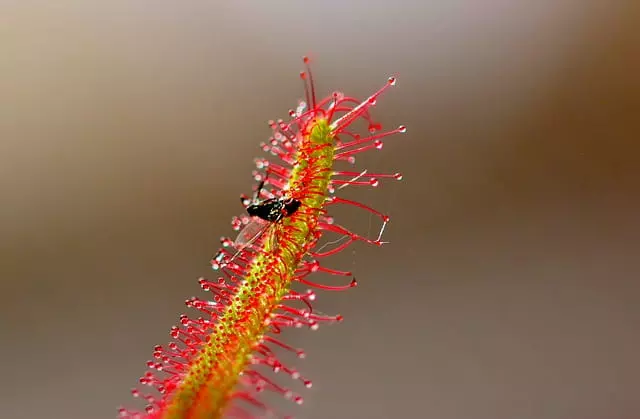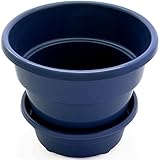The Sundews (Drosera) is a perennial plant. It has a rosette shape. Its leaves are covered with sticky hairs that trap prey, mainly insects. Learn all about how to care for Sundews in this article.
The sticky liquid is called mucilage. After it touches them, the prey is trapped in the sticky mucilage that prevents them from escaping, later the insect will die as the mucilage envelops it and covers its spiracles. Enzymes digest it and release its nutrients which will then be absorbed by the leaf surface. The speed of this capture is moderate and the whole process can last from a few hours to several days.
As for the flowers, they have 5 petals, are white or pinkish, and are distributed on a tall stem of 3” (8 cm), always staying above the leaves.
This plant has more than 20 flowers per stem and each one has 30 seeds and even more.
It measures up to 12” (30 cm) in height and is very easy to grow. Its flowers are white and arranged in spikes, bloom, and fade, in turn, one after the other.
- Live healthy adult sized Drosera capensis (cape sundew)
- Comes with 3 inch pot
- Comes with enough New Zealand sphagnum moss to fill pot
Table of Contents
Characteristics of Sundews
Carnivorous plants are a different group within the plant kingdom. Their bizarre shapes, their insect-based diet, and their strategies for capturing insects are simply fascinating.
They have always aroused a special curiosity. Stories and fantasies of past times described them as terrible beings.
In reality, they only eat insects, and at the most, froglets, small fish, worms, rodent offspring, small scorpions, birds, and reptiles, but very rarely, and this is when they reach adulthood.
For this reason, they are no longer called “insectivorous plants” but “carnivorous plants”, since their diet can include other animals as well as insects.
Most of them live in swampy soils (soils very poor in nitrogen), hence they developed methods to trap animals and thus complete their nutritional needs.
Many of its species can be found all over the world, but more than half of them come from Australia. In Spain, we find the Drosera rotundifolia, in the Pyrenees. There are more than 100 species of Drosera, in addition to many hybrids. This genus is the second largest of the carnivorous plants after Utricularia and in Chile, we find Drosera uniflora.
Given its wide distribution, there are Drosera of the most varied forms and also different requirements in the cultivation of the same. They have leaves of various shapes and sizes, which are covered with small glandular hairs, divided into two types.
All species have leaves with tentacles on top. These tentacles produce a kind of glue called mucilage so that there are several drops of glue at the end of each tentacle.
Depending on the species, these hairs are more or less mobile and embrace the victim to immobilize it and increase the surface in contact, and even, in some species, it is the leaves that wrap around the insect.
The flowers are usually small, white, pinkish, or reddish and the seeds are very fine, as they are dispersed by the wind and germinate in the light (without being covered with soil).
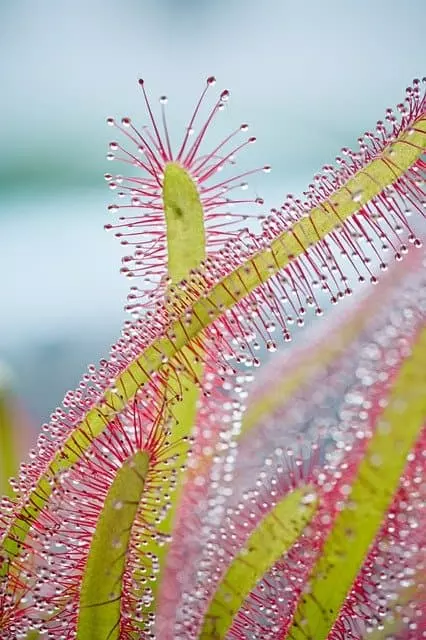
How to Care for Sundews
Subtropical sundews are the most popular and easiest to grow. We can find the following species:
*Drosera capensis
*Drosera aliciae
*Drosera spatulata
*Drosera binate
Others are more demanding and are reserved for experts, such as:
*Drosera adelae
*Drosera burmanii
*Drosera nordic
*Drosera regia
*Most of the bulbous Drosera
*Drosera schizandra
Follow these steps to learn how to properly care for Sundews.
Light
It is recommended a lot of light to take care of the Sundews correctly, but without going overboard, this means, that at the moment of giving them direct sunlight these should be between 7:00 am to 11:00 am (without being moved from its position only that these do not get sunlight). Also, it is recommended that these, at the moment of being indirect light, are with abundant distilled water.
How to Care for Sundews – Temperatures
For sub-tropical Sundews, the temperature between 68 and 95°F (20 and 35°C) in summer and winter should not drop below 50°F (10°C). They do not have a marked rest period, sub-tropical Sundews do not hibernate, they can be all year with a fixed temperature, beware of cold when temperatures are prolonged low, they can die.
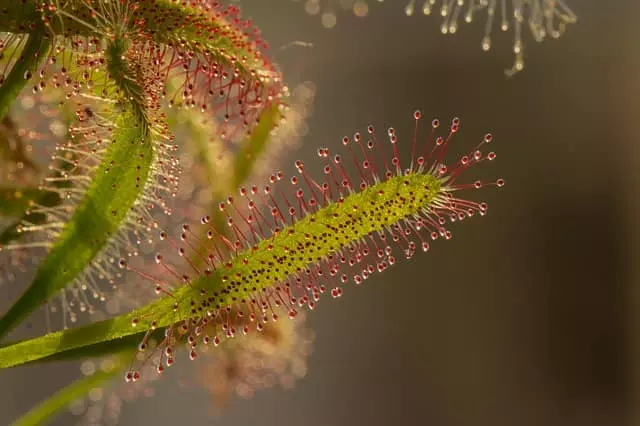
Humidity
The ideal humidity for sundews in terrariums is between 40 and 70%. As a help, I always have them with ambient humidity which is not the same as having them always with water in their tray. It is recommended not to spray the plant daily, if you are concerned that it does not produce mucilage just ensure good light for the plant and leave it in a fixed place.
How to Care for Sundews – Substrate
I recommend a substrate that should drain well: 60% pure peat moss, and 40% perlite. Another option can be: 2 parts of pure peat moss and 1 part of quartz sand, that’s what I use. We recommend this substrate for the proper care of Sundews (Order it here).
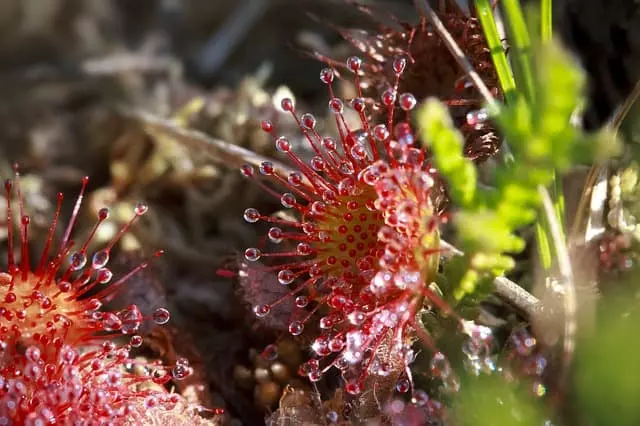
Watering
Keep the substrate always humid. Water it during the whole year by putting the pot in a tray with about 1” (2.5 cm of water), this water should never be tap water (only distilled or rainwater). Avoid wetting the foliage during watering, i.e. the plant. Irrigate with water free of minerals. It is recommended to water through a tray, placing the pot of the plant inside it.
Feeding Sundews
When an insect lands on a leaf, the long tentacles on the edges move and squeeze the prey onto the leaf, at the same time producing more glue. The prey usually suffocates to death from the glue. In some species (Drosera capensis, for example), the leaf is folded over the prey to increase the contact surface. This process can take hours or even days.
Repotting Sundews
Repotting it in spring is ideal, to a wide and deep pot. It is recommended to repot the Sundew an average of once every two years.
- SELF-WATERING, 2-WEEKS+ DEEP RESERVOIR: No more troublesome wicks that clog and stop working. Our patented design integrates a self-watering feature into the body of the planter. Hollow legs reach down into the reservoir to allow the soil itself to draw moisture naturally while lifting your plant above the water, keeping its delicate root system from being constantly flooded, minimizing upkeep while eliminating common problems associated with other planters and with over-watering.
- SELF-AERATING, HIGH DRAINAGE, MINIMIZE ROOT ROT: No need to keep poking holes in your soil. Integrated into the body of the planter are additional large open slats on the bottom that are designed to maintain air circulation through the soil, minimizing the risk of root rot commonly found in more enclosed self-watering planters.
- WATER FROM THE BOTTOM + WON'T WATERLOG: Fill up the deep saucer directly instead of pouring water through the soil and guessing when to stop. Excess water drains rapidly out of the soil away from fragile root systems. If left outside, rainstorms will no longer flood your outdoor potted plants, as the pot will happily refill its reservoir while keeping the soil and roots above water.
How to Propagate Sundews
Propagation by seed is an effective and fast method for subtropical Sundews. Most species are self-pollinating, i.e. it is not necessary to pollinate yourself. If you get any plant to give you seeds, you should sow them after treating them with fungicide, keeping the humidity high, intense light, and keeping them at temperatures between 70 to 84°F (21-29ºC).
Germination time is also quite variable in this group, occurring within a few weeks in some species and taking up to a year in others.
Drosera aliciae and Drosera capensis are self-pollinating (no artificial pollination is necessary), so make sure that the seeds do not disperse through the substrate if you have planted several species together, as the young plants would invade the whole space.
We hope this article on how to care for sundews will be helpful. We recommend our articles about how to take care Venus fly trap and How does Venus fly trap work.
